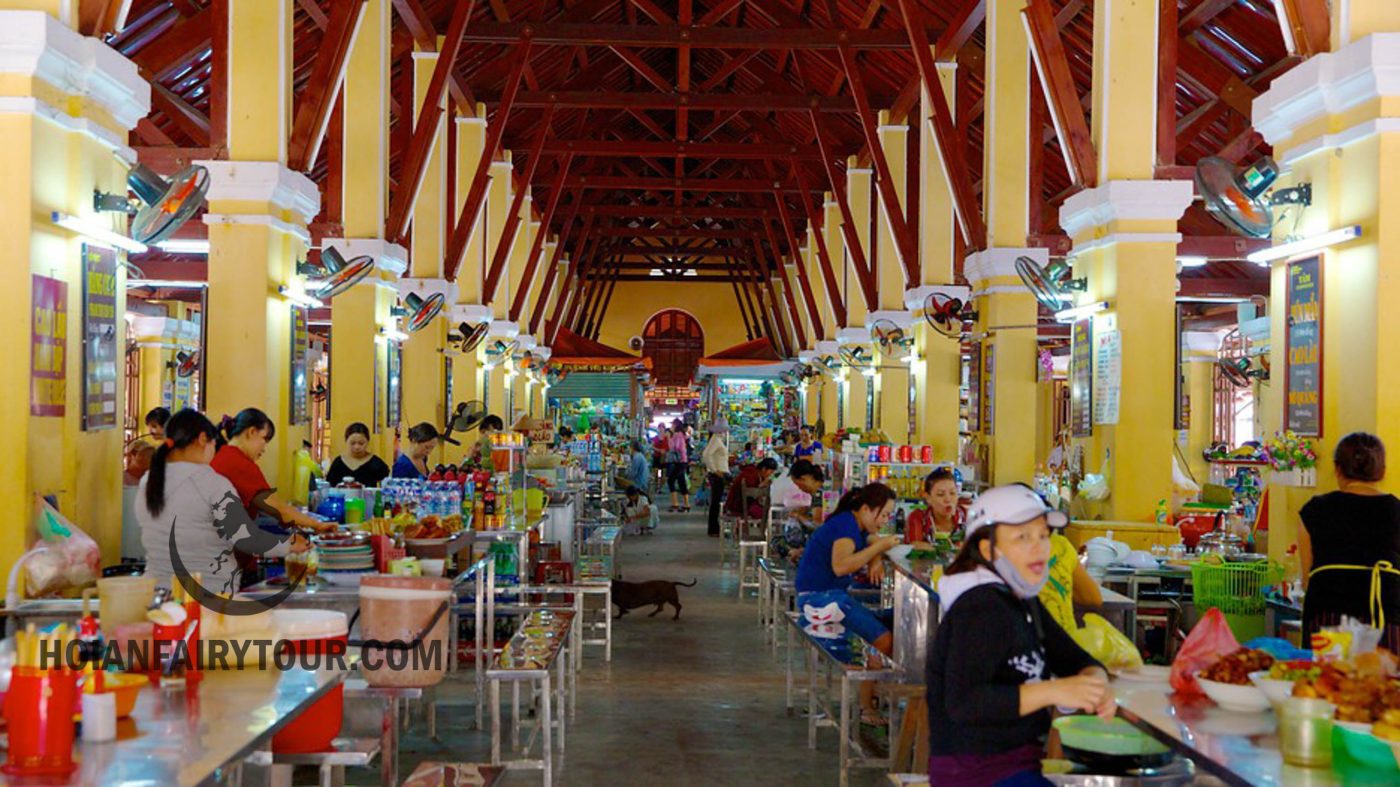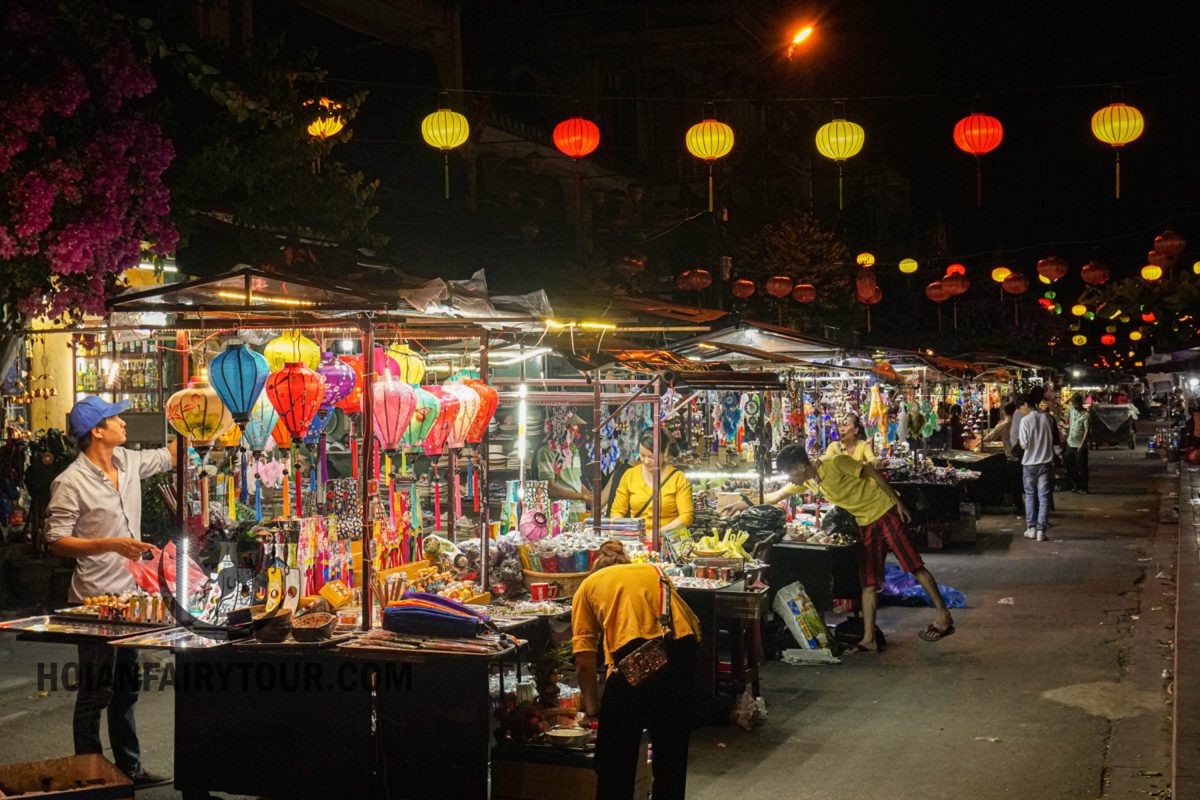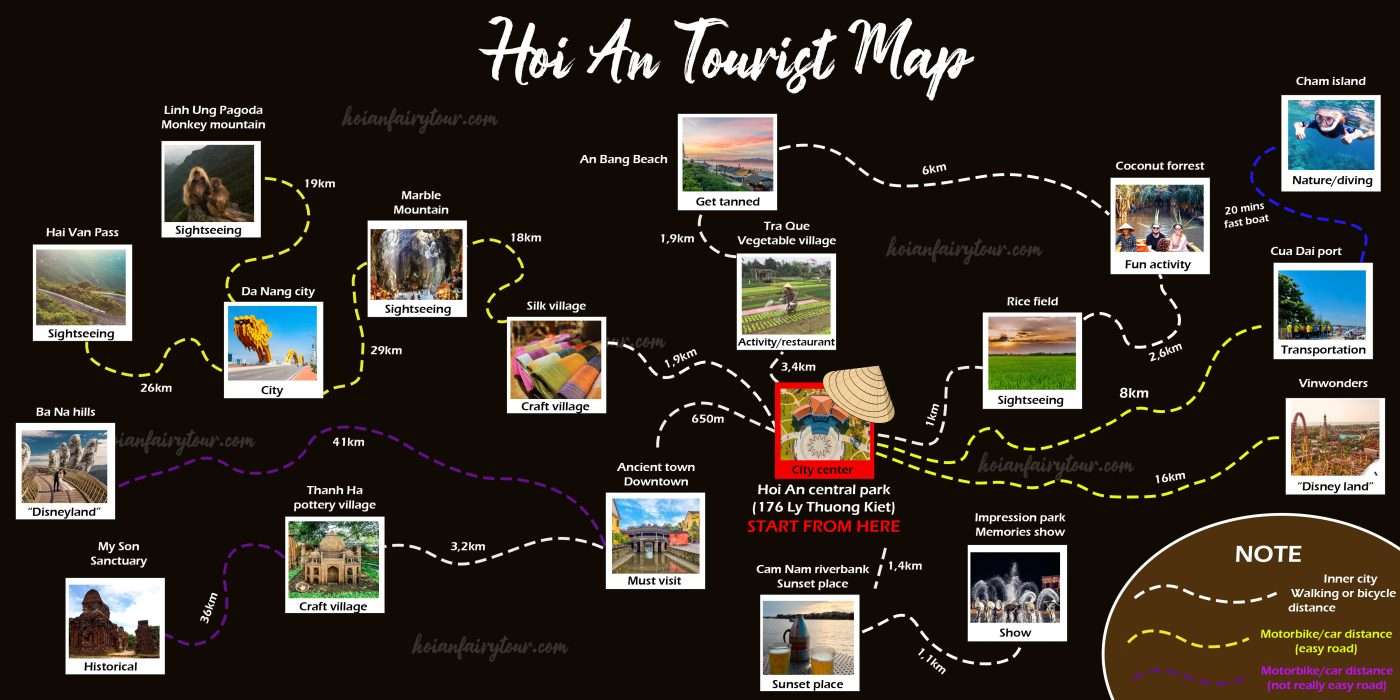Exploring the Vibrant Markets in Hoi An:
Hoi An – a UNESCO World Heritage Site, is not only famous for its well-preserved old town and rich cultural heritage, but also for its vibrant and bustling markets. Visiting these markets offers tourists a glimpse into the local lifestyle, culinary delights, and unique handicraft. Here is a guide to some of the most notable markets in Hoi An, providing useful information for tourists seeking authentic experiences.
1. Hoi An Central Market (Chợ Hội An)
Location: Nguyen Hue and Tran Phu Street, Hoi An Ancient Town – Markets in Hoi An
Highlights:
- Fresh Produce: The market is bustling with vendors selling a wide range of fresh produce, including fruits, vegetables, herbs, and spices. It’s a great place to see and sample local ingredients.
- Seafood Section: Hoi An Central Market boasts an impressive seafood section, where visitors can find fresh catches of the day. This is an ideal spot for those who want to experience the coastal flavors of Hoi An.
- Tailor Shops: The market is famous for its tailor shops, where tourists can get custom-made clothing. Skilled tailors can create everything from suits and dresses to traditional Vietnamese attire.
- Local Snacks and Street Food: A visit to this market isn’t complete without tasting the local street food. Popular dishes include Cao Lau, Banh Mi, and fresh spring rolls.
Tips – Markets in Hoi An
- Bargaining is expected, so don’t hesitate to negotiate prices.
- Visit early in the morning to experience the market at its liveliest and to get the freshest produce.

2. Night Market (Chợ Đêm Hội An)
Location: Nguyen Hoang Street, near the Japanese Covered Bridge – Markets in Hoi An
Highlights:
- Lanterns: The Night Market is famous for its colorful lanterns, which create a magical atmosphere. These lanterns make for perfect souvenirs and gifts.
- Handicrafts and Souvenirs: Vendors sell a variety of handcrafted items, including jewelry, clothing, and artworks. It’s an excellent place to find unique mementos of your trip.
- Street Performers: The market often features live performances, including traditional music and dance, adding to the festive ambiance.
- Street Food: Like the Central Market, the Night Market offers a plethora of street food options. Be sure to try local delicacies like Banh Xeo (crispy pancakes) and grilled skewers.
Tips – Markets in Hoi An
- The market opens in the late afternoon and runs until around 11 PM.
- It’s less crowded on weekdays, providing a more relaxed shopping experience.

3. Tan An Market (Chợ Tân An)
Location: Tran Hung Dao Street, about 2 km from the ancient town – Markets in Hoi An
Highlights:
- Local Experience: Tan An Market is less touristy than the Central Market, offering a more authentic local shopping experience.
- Affordable Prices: Due to its local nature, prices here are generally lower, making it a great place to buy fresh produce and daily necessities.
- Fresh Flowers: The market has a beautiful selection of fresh flowers, perfect for those who appreciate floral arrangements.
Tips – Markets in Hoi An
- Practice basic Vietnamese phrases; it can help in negotiating and making connections with the vendors.
- Early morning visits are recommended for the freshest products.

4. Ba Le Market (Chợ Bà Lê)
Location: Near Cua Dai Street, a short distance from the ancient town – Markets in Hoi An
Highlights:
- Traditional Atmosphere: Ba Le Market retains a traditional Vietnamese market atmosphere, giving visitors a sense of the local lifestyle.
- Variety of Goods: The market offers a wide range of products, including fresh produce, household items, and clothing.
- Friendly Vendors: The vendors here are known for being friendly and welcoming, making shopping a pleasant experience.
Tips – Markets in Hoi An
- This market is less frequented by tourists, providing a more serene shopping environment.
- Engage with the vendors to learn more about the products and their uses in Vietnamese cuisine.
5. Hoi An Fish Market (Chợ Cá Hội An)
Location: Near Thanh Ha Pottery Village, along the Thu Bon River – Markets in Hoi An
Highlights:
- Fresh Seafood: Hoi An Fish Market is the go-to place for fresh seafood. Fishermen bring in their catches early in the morning, offering a wide variety of fish, crabs, shrimps, and more.
- Riverside Atmosphere: The market’s location along the Thu Bon River provides a scenic backdrop, making the experience of buying seafood even more memorable.
- Local Interaction: This market is primarily frequented by locals, offering visitors a genuine glimpse into the daily life of Hoi An’s fishing community.
Tips – Markets in Hoi An
- Visit early in the morning, around 5-6 AM, to witness the market at its peak and to get the freshest seafood.
- Bring a local guide or a friend who speaks Vietnamese to help with bargaining and selecting the best catches.
Outbound Links
For more information on planning your trip to Hoi An, check out these helpful resources:
How to Shop at the Markets in Hoi An
Shopping at the markets in Hoi An is a delightful experience, offering a unique blend of cultural immersion, culinary exploration, and the chance to engage with local vendors. Whether you’re a first-time visitor or a seasoned traveler, understanding how to navigate these markets will enhance your experience and help you get the best deals.
1. Timing is Everything – Markets in Hoi An
To truly experience the vibrancy of Hoi An’s markets, timing your visit is crucial. Early morning is the best time to visit, especially for fresh produce and seafood. The markets are busiest between 6:00 AM and 9:00 AM when vendors bring in their freshest goods, and locals come to buy ingredients for the day. Visiting early also means you get to enjoy the market before the crowds arrive, allowing for a more relaxed shopping experience.
2. Bargaining Like a Local – Markets in Hoi An
Bargaining is an integral part of shopping in Vietnamese markets. While it might feel unfamiliar to some, it’s expected and even seen as a friendly interaction. Start by asking the price of an item, and then counter with a price slightly lower than what you’re willing to pay. From there, you and the vendor can negotiate until you reach an agreement. Remember to stay polite and smile—bargaining is as much about building rapport as it is about getting a good deal. A good rule of thumb is to offer about 50-70% of the initial asking price, depending on the product.
3. Language and Communication – Markets in Hoi An
While many vendors in Hoi An’s markets understand basic English, learning a few Vietnamese phrases can go a long way in enhancing your shopping experience. Simple phrases like “Bao nhiêu?” (How much?), “Giảm giá?” (Discount?), and “Cảm ơn” (Thank you) can help you communicate more effectively. Even if your pronunciation isn’t perfect, vendors will appreciate the effort and may be more inclined to offer you a better deal.
4. Knowing the Products – Markets in Hoi An
Understanding what you’re buying is crucial, especially when it comes to fresh produce, meat, and seafood. Ask vendors about the origin of their products—many will proudly tell you where their goods come from. For instance, vegetables and fruits from Tra Que Village, a nearby organic farming area, are known for their high quality. When buying seafood, check for freshness by looking at the color and texture; fresh fish should have clear eyes, bright red gills, and firm flesh.
5. Carrying Cash – Markets in Hoi An
Vietnamese markets are cash-only environments, so it’s essential to carry enough Vietnamese dong (VND) with you. While larger denominations are accepted, it’s advisable to bring smaller notes for easier transactions, especially when buying smaller items like fruits or vegetables. ATMs are available in Hoi An, but withdrawing cash before heading to the market is a good practice.
6. Sustainable Shopping – Markets in Hoi An
As a responsible traveler, consider bringing your own reusable bags or baskets to minimize plastic waste. Many vendors still use plastic bags, but they’ll appreciate it if you bring your own. Additionally, buying directly from local vendors supports small businesses and ensures your money stays within the community.

Market Prices in Hoi An – Markets in Hoi An
To give you a better idea of what to expect when shopping at the markets in Hoi An, here’s a list of approximate prices for common products:
- Eggs (Trứng):
- Local chicken eggs: 3,000 – 4,000 VND per egg
- Duck eggs: 4,000 – 5,000 VND per egg
- Meat (Thịt):
- Pork (thịt heo): 120,000 – 150,000 VND per kilogram
- Beef (thịt bò): 180,000 – 250,000 VND per kilogram
- Chicken (thịt gà): 90,000 – 120,000 VND per kilogram
- Fish (Cá):
- Fresh fish (varieties like mackerel, snapper): 70,000 – 150,000 VND per kilogram, depending on the type
- Shrimp (Tôm): 200,000 – 300,000 VND per kilogram
- Crab (Cua): 250,000 – 400,000 VND per kilogram
- Fruit (Trái cây):
- Bananas (Chuối): 20,000 – 30,000 VND per kilogram
- Mangoes (Xoài): 50,000 – 80,000 VND per kilogram
- Dragon fruit (Thanh long): 30,000 – 50,000 VND per kilogram
- Oranges (Cam): 40,000 – 60,000 VND per kilogram
- Vegetables (Rau củ):
- Morning glory (Rau muống): 10,000 – 15,000 VND per bunch
- Carrots (Cà rốt): 15,000 – 25,000 VND per kilogram
- Cabbage (Bắp cải): 10,000 – 20,000 VND per kilogram
- Tomatoes (Cà chua): 15,000 – 30,000 VND per kilogram
These prices can vary depending on the season and market location. Prices may be higher in more tourist-centric areas, but bargaining can help you secure a better deal. Keep in mind that while these markets offer an opportunity to save money, they also provide a way to directly support local farmers and artisans, making every purchase a meaningful one.
Convenient Services at Hoi An Fairy Tour
To fully enjoy these local-only restaurant in Hoi An, consider the convenient services offered by Hoi An Fairy Tour. Whether you need a taxi, a guided tour, motorbike rental, a sleeper bus, or a boat to Cham Island, they provide reliable and affordable options to make your culinary adventure hassle-free.
Conclusion
For a well-rounded experience, Hoi An Central Market and the Night Market are the top recommendations for tourists. They offer a mix of cultural immersion, shopping opportunities, and culinary delights, ensuring visitors can enjoy the best of what Hoi An has to offer. For those looking to delve deeper into local life, Tan An Market and Ba Le Market provide more authentic and relaxed alternatives.
From Vincent – the Author
If you find this post useful and would like to show your appreciation, you can support me by making a donation via PayPal. Your generosity helps me continue creating helpful content. Thank you!
Paypal Link: [Click here]
HOI AN FAIRY TOUR – HOME – TAXI – TOUR/SHOW – BIKE/BUS/BOAT – LOCAL RECOMMENED
